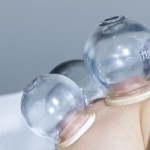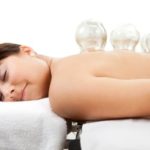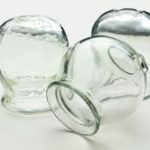Cupping Therapy – Questions and Answers
Cupping Therapy is an increasingly popular treatment that can have big benefits for muscle pain and tension. Eric Schmidt, LAc was recently interviewed by a major Los Angeles publication on the topic of cupping. After the interview, the publisher was nice enough to allow us to re-print the answers on our website. Enjoy!
Q: Please describe the process in your own words. 
At its core, cupping is a massage in reverse. Instead adding pressure to muscles and connective tissue (as in massage), cupping creates expansion and space in the tissues and promotes blood flow.
The key to a good cupping session is: a.) large glass cups, b.) a flaming cotton ball and c.) massage oil. For most cupping sessions, the recipient is positioned lying face down to address muscles on the back, neck or shoulders. Once the patient is lying in a comfortable position the cup is quickly warmed with a flame and then the cup is placed on the skin. Although the cup itself will not be hot, the heated air inside the cup cools quickly, the cooling effect creates vacuum in side the cup. The result is skin and the muscles underneath being pulled upward for a bit of a stretch. Each cup placement is left for 2-5 minutes, which is all that is required to get a beneficial effect. In a typical cupping session we do 2-5 placements on different muscles, depending on the size of the effected area. For most people, the experience of cupping is pretty neutral – meaning it doesn’t feel especially good or bad while the cups are on the skin. The sensation is more of a pulling or grabbing that becomes less intense the longer the cup is left in place.
After a cupping session people usually see an immediate change in muscle tension and pain. Patients often get off the treatment table and remark that it “feels like a weight has been lifted off my shoulders”. While the pain-relieving effects of acupuncture can take a bit longer to kick in, the relief from cupping is usually pretty immediate.
Q: Have you noticed a shift in awareness about alternative eastern medicine practices? Particularly in a younger age bracket?
Yes, definitely! The younger generation seems to be the age group most  interested looking for alternatives to the established medical system. In my practice, I hear many people grumbling about their Western doctors, so there is a natural interest in finding better health care solutions.
interested looking for alternatives to the established medical system. In my practice, I hear many people grumbling about their Western doctors, so there is a natural interest in finding better health care solutions.
The older generation often has the mindset where a doctor’s advice is gospel and even small decisions need to be approved by their doctor. In contrast, the younger generation feels empowered to do research make many health-related decisions themselves. This includes being more proactive in utilizing “alternative medicine” approaches, like cupping, acupuncture or herbal medicine.
Q: Have you ever had patients mention they found out about cupping through the media/via celebrity culture?
Many people know the famous event when Gwyneth Paltrow arrived up on the Red Carpet and showed off cupping marks on her shoulders. That day Gwyneth really raised the public awareness of cupping, to such a great extent that I still get asked about it frequently.
The other big media event that comes to mind was when Oprah had an acupuncturist on her TV show. I don’t think there much discussion of cupping at the time, but that episode really brought a huge amount of attention to Traditional Chinese Medicine. (fyi, Oprah’s dog also gets acupuncture)
Lastly, I recently saw a commercial for Under Armour with Olympic swimmer Michael Phelps. In the video there is a 3 second clip where Michael is having cupping done. That made me happy. I also happen to know that the Chinese Olympic swim team incorporates cupping therapy into their training plan.
Q: Why do you think it’s become more visible in the entertainment industry?
Although I live in Los Angeles I know very little about the entertainment industry. However, I do get the sense that there is more media coverage of cupping and acupuncture in general. If I had to guess why, I would say that the medicine is becoming more accessible and less intimidating as more non-Chinese practitioners, like myself, offer cupping and acupuncture. Also, cupping works! As more people try cupping for their muscle tension and have good results, they tend to tell their friends.
Q: What should people know about cupping?
 Cupping has been used traditionally in many different cultures, and not just in China. In addition to China, Japan and Korea, the Russians and Eastern European countries have a long history of cupping. In many of these countries, families will have a set of cups that are used for lung conditions (like colds) and for general aches and pains. I have also had patients from Pakistan and Northern Africa tell me that cupping was a traditional treatment method in their country.
Cupping has been used traditionally in many different cultures, and not just in China. In addition to China, Japan and Korea, the Russians and Eastern European countries have a long history of cupping. In many of these countries, families will have a set of cups that are used for lung conditions (like colds) and for general aches and pains. I have also had patients from Pakistan and Northern Africa tell me that cupping was a traditional treatment method in their country.
Also, if you go to Chinatown for a cupping session there’s the standard tag-line that cupping “removes toxins” from the body. Although the “toxin theory” may have some truth, I prefer to avoid such phraseology and explain cupping in simpler terms.
My explanation for cupping is that the vacuum of the cups gives the muscles a stretch and expansion. As the local muscles are stretched and given more space, blood is pumped through the muscles and circulated through the local area. This means that cupping is addressing the two main causes of muscle tension & pain: a.) poor blood flow and b.) shortened or contracted muscles.
Q: What type of patients can best benefit from the treatment?
Cupping can work miracles on tight muscles in the upper back, shoulders and neck. The classic presentation would be the sensation of tight “knots” in the shoulders where the tension can be radiating up to the neck. These upper body areas are especially amenable to cupping therapy because the muscles involved are smaller and close to the surface of the body.
Cupping can also be helpful for low back pain, but often the muscles involved in low back pain are deeper spinal muscles where cupping on the surface of the skin cannot have as big of an effect. For deeper muscle structures, acupuncture is generally more effective. For most cases I actually combine cupping with acupuncture, but they can both be effective when used alone.
